Climate Change Policies in Poland
VerifiedAdded on 2022/12/26
|6
|1151
|21
AI Summary
This document provides an overview of climate change policies in Poland after 1990. It discusses the changes in policies in sectors such as agriculture, transport, renewable energy, and energy. It also examines the causes of policy failure. The document includes references for further reading.
Contribute Materials
Your contribution can guide someone’s learning journey. Share your
documents today.
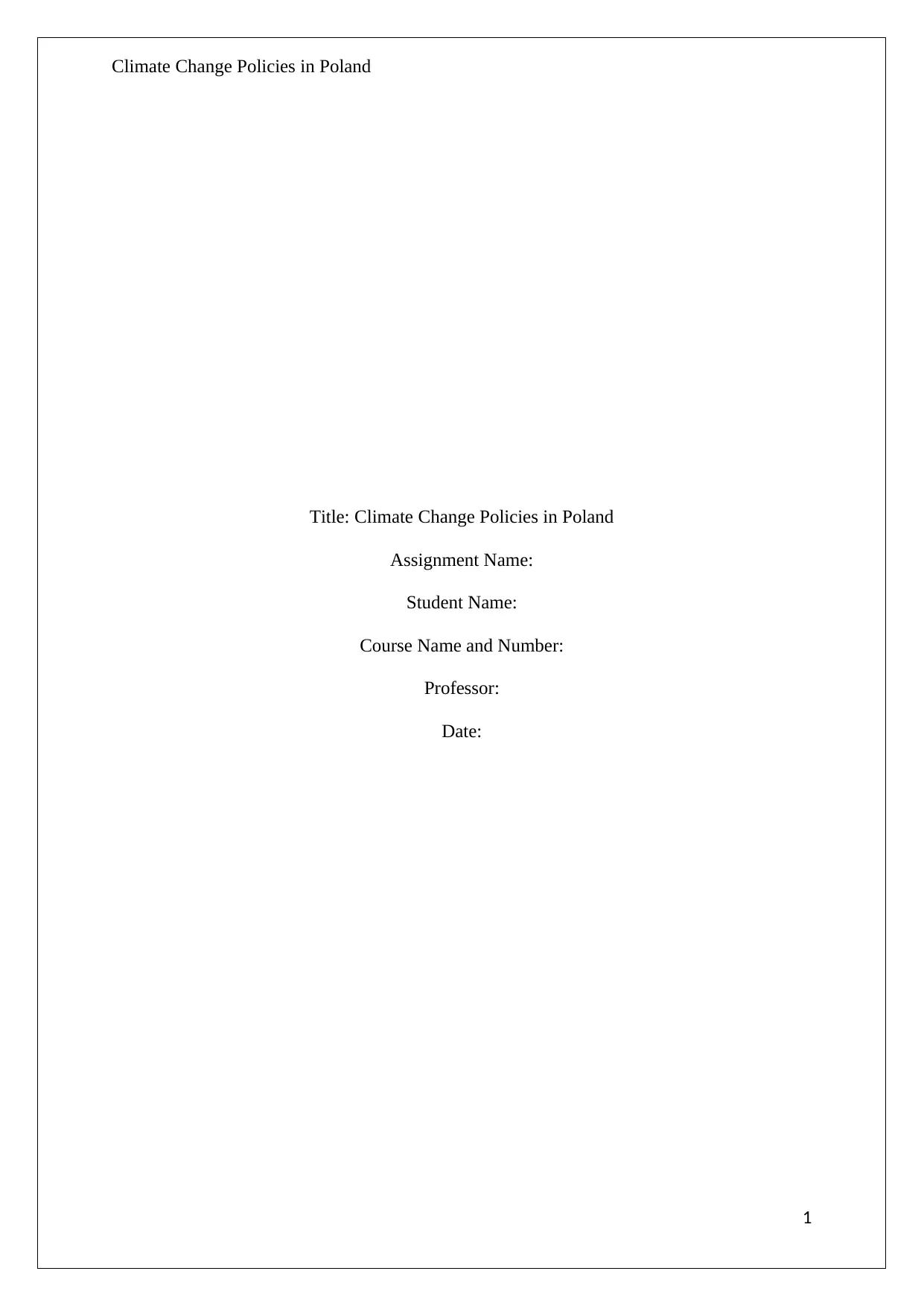
Climate Change Policies in Poland
Title: Climate Change Policies in Poland
Assignment Name:
Student Name:
Course Name and Number:
Professor:
Date:
1
Title: Climate Change Policies in Poland
Assignment Name:
Student Name:
Course Name and Number:
Professor:
Date:
1
Secure Best Marks with AI Grader
Need help grading? Try our AI Grader for instant feedback on your assignments.
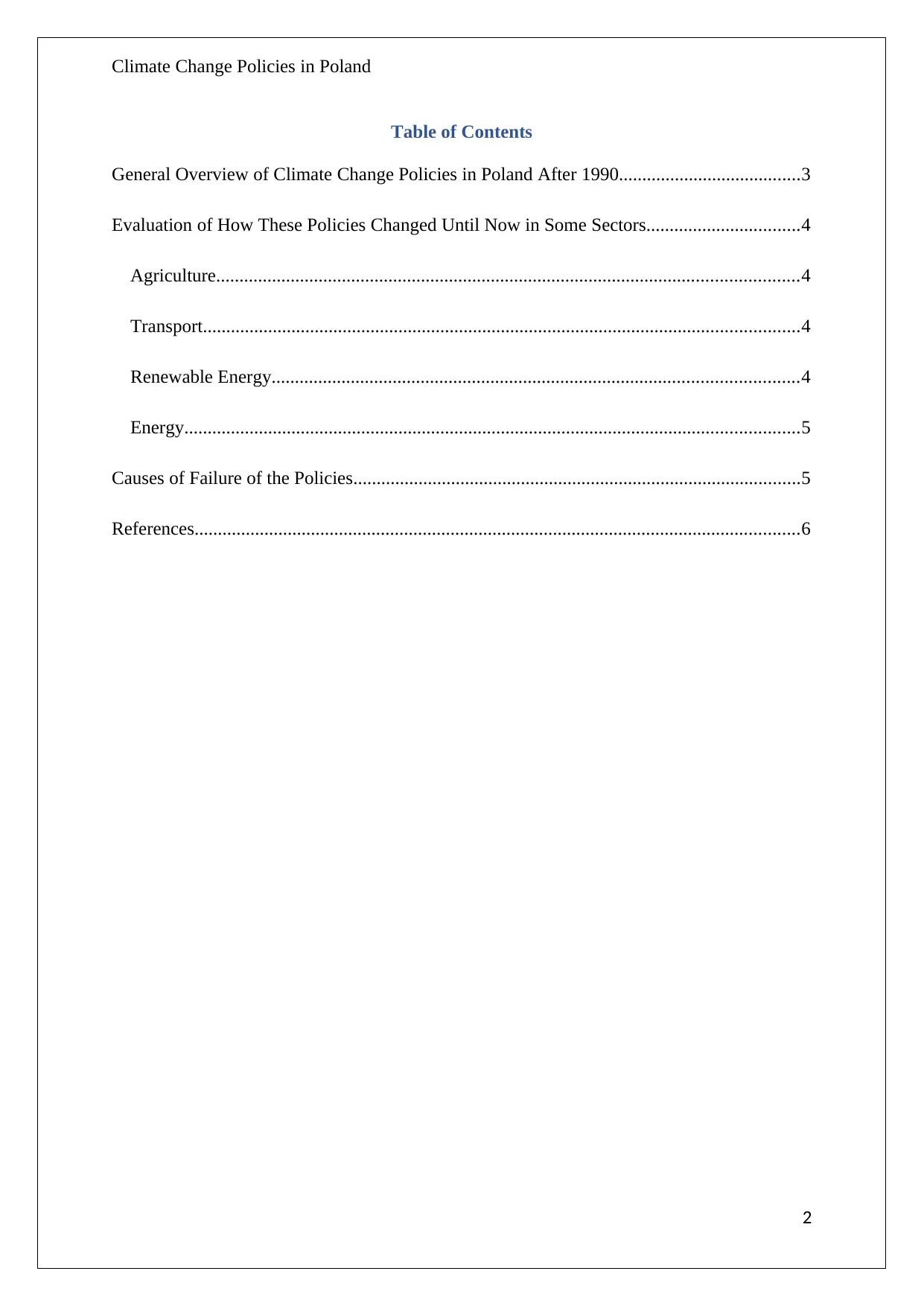
Climate Change Policies in Poland
Table of Contents
General Overview of Climate Change Policies in Poland After 1990.......................................3
Evaluation of How These Policies Changed Until Now in Some Sectors.................................4
Agriculture.............................................................................................................................4
Transport................................................................................................................................4
Renewable Energy.................................................................................................................4
Energy....................................................................................................................................5
Causes of Failure of the Policies................................................................................................5
References..................................................................................................................................6
2
Table of Contents
General Overview of Climate Change Policies in Poland After 1990.......................................3
Evaluation of How These Policies Changed Until Now in Some Sectors.................................4
Agriculture.............................................................................................................................4
Transport................................................................................................................................4
Renewable Energy.................................................................................................................4
Energy....................................................................................................................................5
Causes of Failure of the Policies................................................................................................5
References..................................................................................................................................6
2
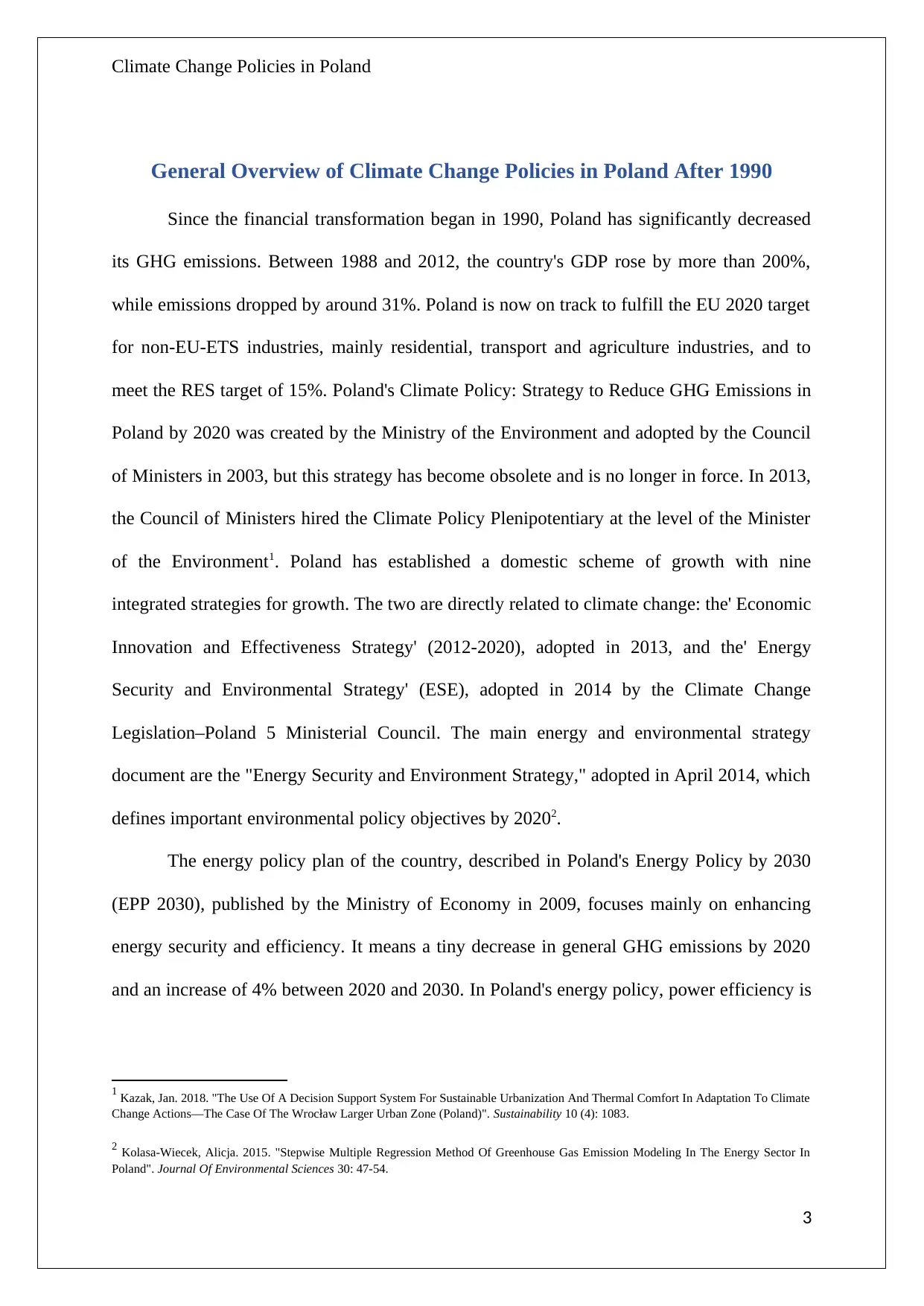
Climate Change Policies in Poland
General Overview of Climate Change Policies in Poland After 1990
Since the financial transformation began in 1990, Poland has significantly decreased
its GHG emissions. Between 1988 and 2012, the country's GDP rose by more than 200%,
while emissions dropped by around 31%. Poland is now on track to fulfill the EU 2020 target
for non-EU-ETS industries, mainly residential, transport and agriculture industries, and to
meet the RES target of 15%. Poland's Climate Policy: Strategy to Reduce GHG Emissions in
Poland by 2020 was created by the Ministry of the Environment and adopted by the Council
of Ministers in 2003, but this strategy has become obsolete and is no longer in force. In 2013,
the Council of Ministers hired the Climate Policy Plenipotentiary at the level of the Minister
of the Environment1. Poland has established a domestic scheme of growth with nine
integrated strategies for growth. The two are directly related to climate change: the' Economic
Innovation and Effectiveness Strategy' (2012-2020), adopted in 2013, and the' Energy
Security and Environmental Strategy' (ESE), adopted in 2014 by the Climate Change
Legislation–Poland 5 Ministerial Council. The main energy and environmental strategy
document are the "Energy Security and Environment Strategy," adopted in April 2014, which
defines important environmental policy objectives by 20202.
The energy policy plan of the country, described in Poland's Energy Policy by 2030
(EPP 2030), published by the Ministry of Economy in 2009, focuses mainly on enhancing
energy security and efficiency. It means a tiny decrease in general GHG emissions by 2020
and an increase of 4% between 2020 and 2030. In Poland's energy policy, power efficiency is
1 Kazak, Jan. 2018. "The Use Of A Decision Support System For Sustainable Urbanization And Thermal Comfort In Adaptation To Climate
Change Actions—The Case Of The Wrocław Larger Urban Zone (Poland)". Sustainability 10 (4): 1083.
2 Kolasa-Wiecek, Alicja. 2015. "Stepwise Multiple Regression Method Of Greenhouse Gas Emission Modeling In The Energy Sector In
Poland". Journal Of Environmental Sciences 30: 47-54.
3
General Overview of Climate Change Policies in Poland After 1990
Since the financial transformation began in 1990, Poland has significantly decreased
its GHG emissions. Between 1988 and 2012, the country's GDP rose by more than 200%,
while emissions dropped by around 31%. Poland is now on track to fulfill the EU 2020 target
for non-EU-ETS industries, mainly residential, transport and agriculture industries, and to
meet the RES target of 15%. Poland's Climate Policy: Strategy to Reduce GHG Emissions in
Poland by 2020 was created by the Ministry of the Environment and adopted by the Council
of Ministers in 2003, but this strategy has become obsolete and is no longer in force. In 2013,
the Council of Ministers hired the Climate Policy Plenipotentiary at the level of the Minister
of the Environment1. Poland has established a domestic scheme of growth with nine
integrated strategies for growth. The two are directly related to climate change: the' Economic
Innovation and Effectiveness Strategy' (2012-2020), adopted in 2013, and the' Energy
Security and Environmental Strategy' (ESE), adopted in 2014 by the Climate Change
Legislation–Poland 5 Ministerial Council. The main energy and environmental strategy
document are the "Energy Security and Environment Strategy," adopted in April 2014, which
defines important environmental policy objectives by 20202.
The energy policy plan of the country, described in Poland's Energy Policy by 2030
(EPP 2030), published by the Ministry of Economy in 2009, focuses mainly on enhancing
energy security and efficiency. It means a tiny decrease in general GHG emissions by 2020
and an increase of 4% between 2020 and 2030. In Poland's energy policy, power efficiency is
1 Kazak, Jan. 2018. "The Use Of A Decision Support System For Sustainable Urbanization And Thermal Comfort In Adaptation To Climate
Change Actions—The Case Of The Wrocław Larger Urban Zone (Poland)". Sustainability 10 (4): 1083.
2 Kolasa-Wiecek, Alicja. 2015. "Stepwise Multiple Regression Method Of Greenhouse Gas Emission Modeling In The Energy Sector In
Poland". Journal Of Environmental Sciences 30: 47-54.
3
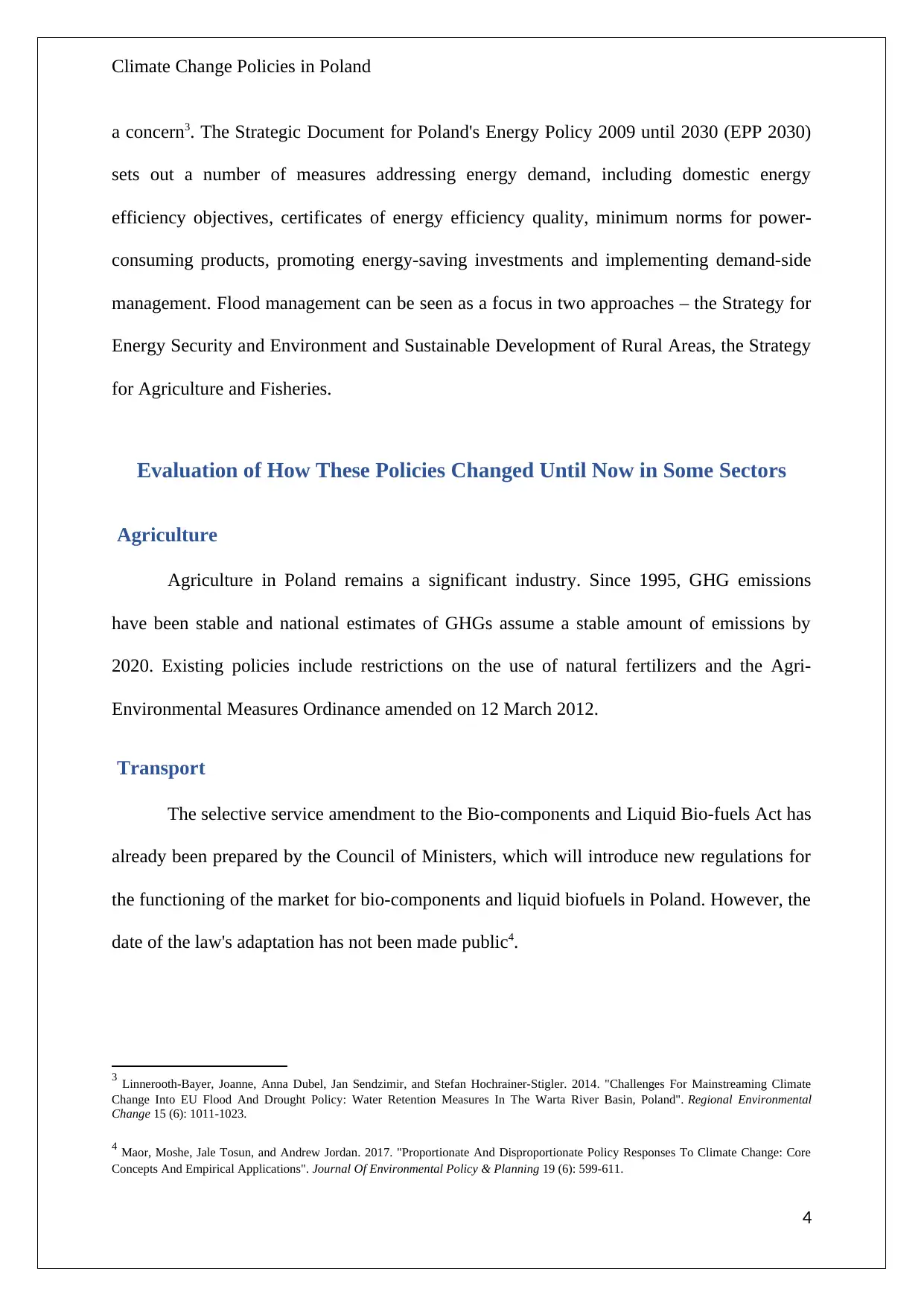
Climate Change Policies in Poland
a concern3. The Strategic Document for Poland's Energy Policy 2009 until 2030 (EPP 2030)
sets out a number of measures addressing energy demand, including domestic energy
efficiency objectives, certificates of energy efficiency quality, minimum norms for power-
consuming products, promoting energy-saving investments and implementing demand-side
management. Flood management can be seen as a focus in two approaches – the Strategy for
Energy Security and Environment and Sustainable Development of Rural Areas, the Strategy
for Agriculture and Fisheries.
Evaluation of How These Policies Changed Until Now in Some Sectors
Agriculture
Agriculture in Poland remains a significant industry. Since 1995, GHG emissions
have been stable and national estimates of GHGs assume a stable amount of emissions by
2020. Existing policies include restrictions on the use of natural fertilizers and the Agri-
Environmental Measures Ordinance amended on 12 March 2012.
Transport
The selective service amendment to the Bio-components and Liquid Bio-fuels Act has
already been prepared by the Council of Ministers, which will introduce new regulations for
the functioning of the market for bio-components and liquid biofuels in Poland. However, the
date of the law's adaptation has not been made public4.
3 Linnerooth-Bayer, Joanne, Anna Dubel, Jan Sendzimir, and Stefan Hochrainer-Stigler. 2014. "Challenges For Mainstreaming Climate
Change Into EU Flood And Drought Policy: Water Retention Measures In The Warta River Basin, Poland". Regional Environmental
Change 15 (6): 1011-1023.
4 Maor, Moshe, Jale Tosun, and Andrew Jordan. 2017. "Proportionate And Disproportionate Policy Responses To Climate Change: Core
Concepts And Empirical Applications". Journal Of Environmental Policy & Planning 19 (6): 599-611.
4
a concern3. The Strategic Document for Poland's Energy Policy 2009 until 2030 (EPP 2030)
sets out a number of measures addressing energy demand, including domestic energy
efficiency objectives, certificates of energy efficiency quality, minimum norms for power-
consuming products, promoting energy-saving investments and implementing demand-side
management. Flood management can be seen as a focus in two approaches – the Strategy for
Energy Security and Environment and Sustainable Development of Rural Areas, the Strategy
for Agriculture and Fisheries.
Evaluation of How These Policies Changed Until Now in Some Sectors
Agriculture
Agriculture in Poland remains a significant industry. Since 1995, GHG emissions
have been stable and national estimates of GHGs assume a stable amount of emissions by
2020. Existing policies include restrictions on the use of natural fertilizers and the Agri-
Environmental Measures Ordinance amended on 12 March 2012.
Transport
The selective service amendment to the Bio-components and Liquid Bio-fuels Act has
already been prepared by the Council of Ministers, which will introduce new regulations for
the functioning of the market for bio-components and liquid biofuels in Poland. However, the
date of the law's adaptation has not been made public4.
3 Linnerooth-Bayer, Joanne, Anna Dubel, Jan Sendzimir, and Stefan Hochrainer-Stigler. 2014. "Challenges For Mainstreaming Climate
Change Into EU Flood And Drought Policy: Water Retention Measures In The Warta River Basin, Poland". Regional Environmental
Change 15 (6): 1011-1023.
4 Maor, Moshe, Jale Tosun, and Andrew Jordan. 2017. "Proportionate And Disproportionate Policy Responses To Climate Change: Core
Concepts And Empirical Applications". Journal Of Environmental Policy & Planning 19 (6): 599-611.
4
Secure Best Marks with AI Grader
Need help grading? Try our AI Grader for instant feedback on your assignments.
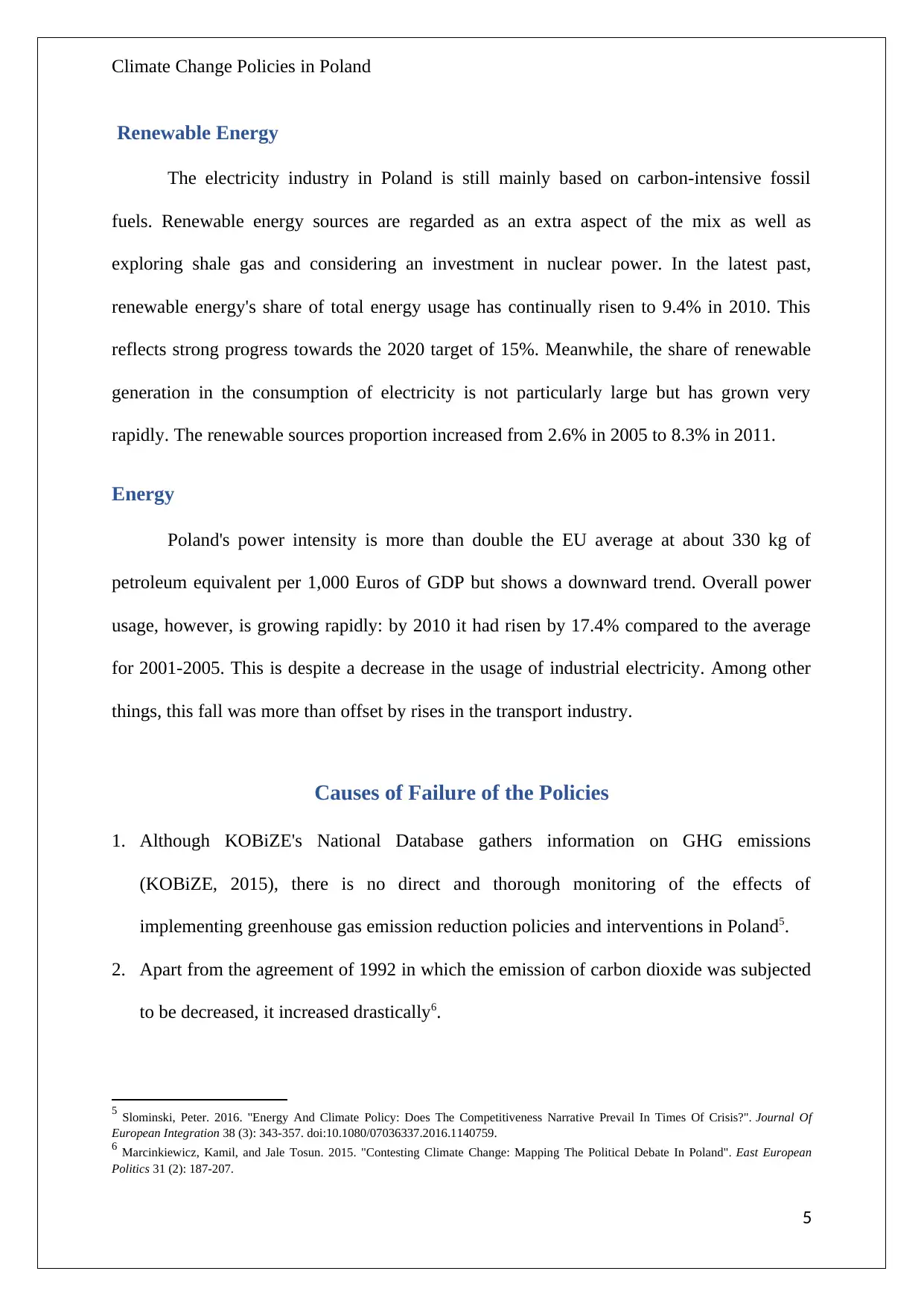
Climate Change Policies in Poland
Renewable Energy
The electricity industry in Poland is still mainly based on carbon-intensive fossil
fuels. Renewable energy sources are regarded as an extra aspect of the mix as well as
exploring shale gas and considering an investment in nuclear power. In the latest past,
renewable energy's share of total energy usage has continually risen to 9.4% in 2010. This
reflects strong progress towards the 2020 target of 15%. Meanwhile, the share of renewable
generation in the consumption of electricity is not particularly large but has grown very
rapidly. The renewable sources proportion increased from 2.6% in 2005 to 8.3% in 2011.
Energy
Poland's power intensity is more than double the EU average at about 330 kg of
petroleum equivalent per 1,000 Euros of GDP but shows a downward trend. Overall power
usage, however, is growing rapidly: by 2010 it had risen by 17.4% compared to the average
for 2001-2005. This is despite a decrease in the usage of industrial electricity. Among other
things, this fall was more than offset by rises in the transport industry.
Causes of Failure of the Policies
1. Although KOBiZE's National Database gathers information on GHG emissions
(KOBiZE, 2015), there is no direct and thorough monitoring of the effects of
implementing greenhouse gas emission reduction policies and interventions in Poland5.
2. Apart from the agreement of 1992 in which the emission of carbon dioxide was subjected
to be decreased, it increased drastically6.
5 Slominski, Peter. 2016. "Energy And Climate Policy: Does The Competitiveness Narrative Prevail In Times Of Crisis?". Journal Of
European Integration 38 (3): 343-357. doi:10.1080/07036337.2016.1140759.
6 Marcinkiewicz, Kamil, and Jale Tosun. 2015. "Contesting Climate Change: Mapping The Political Debate In Poland". East European
Politics 31 (2): 187-207.
5
Renewable Energy
The electricity industry in Poland is still mainly based on carbon-intensive fossil
fuels. Renewable energy sources are regarded as an extra aspect of the mix as well as
exploring shale gas and considering an investment in nuclear power. In the latest past,
renewable energy's share of total energy usage has continually risen to 9.4% in 2010. This
reflects strong progress towards the 2020 target of 15%. Meanwhile, the share of renewable
generation in the consumption of electricity is not particularly large but has grown very
rapidly. The renewable sources proportion increased from 2.6% in 2005 to 8.3% in 2011.
Energy
Poland's power intensity is more than double the EU average at about 330 kg of
petroleum equivalent per 1,000 Euros of GDP but shows a downward trend. Overall power
usage, however, is growing rapidly: by 2010 it had risen by 17.4% compared to the average
for 2001-2005. This is despite a decrease in the usage of industrial electricity. Among other
things, this fall was more than offset by rises in the transport industry.
Causes of Failure of the Policies
1. Although KOBiZE's National Database gathers information on GHG emissions
(KOBiZE, 2015), there is no direct and thorough monitoring of the effects of
implementing greenhouse gas emission reduction policies and interventions in Poland5.
2. Apart from the agreement of 1992 in which the emission of carbon dioxide was subjected
to be decreased, it increased drastically6.
5 Slominski, Peter. 2016. "Energy And Climate Policy: Does The Competitiveness Narrative Prevail In Times Of Crisis?". Journal Of
European Integration 38 (3): 343-357. doi:10.1080/07036337.2016.1140759.
6 Marcinkiewicz, Kamil, and Jale Tosun. 2015. "Contesting Climate Change: Mapping The Political Debate In Poland". East European
Politics 31 (2): 187-207.
5
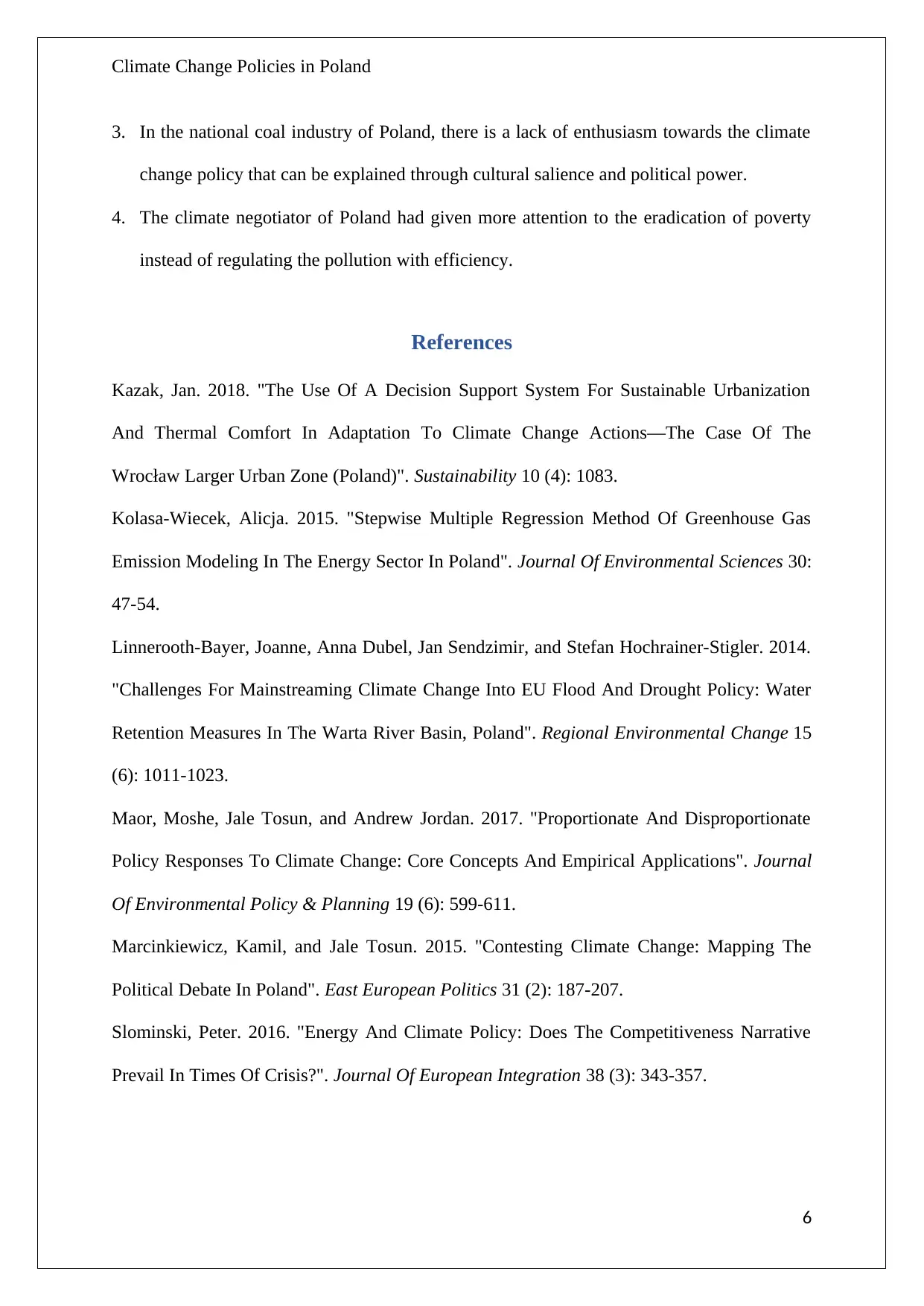
Climate Change Policies in Poland
3. In the national coal industry of Poland, there is a lack of enthusiasm towards the climate
change policy that can be explained through cultural salience and political power.
4. The climate negotiator of Poland had given more attention to the eradication of poverty
instead of regulating the pollution with efficiency.
References
Kazak, Jan. 2018. "The Use Of A Decision Support System For Sustainable Urbanization
And Thermal Comfort In Adaptation To Climate Change Actions—The Case Of The
Wrocław Larger Urban Zone (Poland)". Sustainability 10 (4): 1083.
Kolasa-Wiecek, Alicja. 2015. "Stepwise Multiple Regression Method Of Greenhouse Gas
Emission Modeling In The Energy Sector In Poland". Journal Of Environmental Sciences 30:
47-54.
Linnerooth-Bayer, Joanne, Anna Dubel, Jan Sendzimir, and Stefan Hochrainer-Stigler. 2014.
"Challenges For Mainstreaming Climate Change Into EU Flood And Drought Policy: Water
Retention Measures In The Warta River Basin, Poland". Regional Environmental Change 15
(6): 1011-1023.
Maor, Moshe, Jale Tosun, and Andrew Jordan. 2017. "Proportionate And Disproportionate
Policy Responses To Climate Change: Core Concepts And Empirical Applications". Journal
Of Environmental Policy & Planning 19 (6): 599-611.
Marcinkiewicz, Kamil, and Jale Tosun. 2015. "Contesting Climate Change: Mapping The
Political Debate In Poland". East European Politics 31 (2): 187-207.
Slominski, Peter. 2016. "Energy And Climate Policy: Does The Competitiveness Narrative
Prevail In Times Of Crisis?". Journal Of European Integration 38 (3): 343-357.
6
3. In the national coal industry of Poland, there is a lack of enthusiasm towards the climate
change policy that can be explained through cultural salience and political power.
4. The climate negotiator of Poland had given more attention to the eradication of poverty
instead of regulating the pollution with efficiency.
References
Kazak, Jan. 2018. "The Use Of A Decision Support System For Sustainable Urbanization
And Thermal Comfort In Adaptation To Climate Change Actions—The Case Of The
Wrocław Larger Urban Zone (Poland)". Sustainability 10 (4): 1083.
Kolasa-Wiecek, Alicja. 2015. "Stepwise Multiple Regression Method Of Greenhouse Gas
Emission Modeling In The Energy Sector In Poland". Journal Of Environmental Sciences 30:
47-54.
Linnerooth-Bayer, Joanne, Anna Dubel, Jan Sendzimir, and Stefan Hochrainer-Stigler. 2014.
"Challenges For Mainstreaming Climate Change Into EU Flood And Drought Policy: Water
Retention Measures In The Warta River Basin, Poland". Regional Environmental Change 15
(6): 1011-1023.
Maor, Moshe, Jale Tosun, and Andrew Jordan. 2017. "Proportionate And Disproportionate
Policy Responses To Climate Change: Core Concepts And Empirical Applications". Journal
Of Environmental Policy & Planning 19 (6): 599-611.
Marcinkiewicz, Kamil, and Jale Tosun. 2015. "Contesting Climate Change: Mapping The
Political Debate In Poland". East European Politics 31 (2): 187-207.
Slominski, Peter. 2016. "Energy And Climate Policy: Does The Competitiveness Narrative
Prevail In Times Of Crisis?". Journal Of European Integration 38 (3): 343-357.
6
1 out of 6
Related Documents
Your All-in-One AI-Powered Toolkit for Academic Success.
+13062052269
info@desklib.com
Available 24*7 on WhatsApp / Email
![[object Object]](/_next/static/media/star-bottom.7253800d.svg)
Unlock your academic potential
© 2024 | Zucol Services PVT LTD | All rights reserved.
